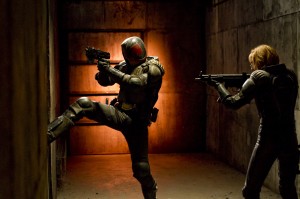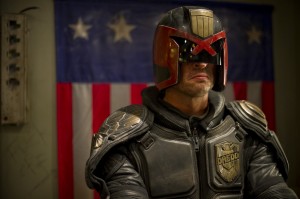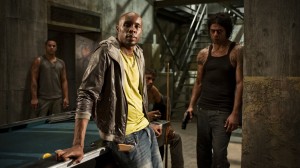
Judge Dredd (Karl Urban) and Cassandra Anderson (Olivia Thirlby) in "Dredd 3D" (Photo by Joe Alblas)
Based on the pulpy British comic strip (and the 1995 Sylvester Stallone-starring film adaptation) Judge Dredd, Dredd 3D is a dystopian action thriller that jumps off the screen thanks to its ambitious use of 3-D technology. But for a film so focused on the sights and sounds of the judges, who act as police, judge, jury and, if needed, executioner, the film is often just as much about what’s not being seen or heard. And Wood Harris’ character Kay is the perfect example of this point. A member of drug lord Ma-Ma’s (Lena Headey) clan, Kay is a street thug taken into custody by Judge Dredd (Karl Urban) and his clairvoyant trainee (Olivia Thirlby). Best known for his own role as a drug lord on The Wire, Harris’ character exercises his right to remain silent for a good portion of Dredd as Ma-Ma and her goons hunt down the very officers who have taken Kay into custody. But with a mind-reading rookie largely in charge of his fate, Kay eventually gets in on the action, verbally and physically. Judgment is out now that the movie is in theaters, and Harris talks to Wrestling with Pop Culture about Dredd‘s filming process and the similarities between the ruthlessness of the criminals and the judges.
For a movie that’s as visually ambitious as this one is, what was the filming process like?
We shot for six months in Africa. I had a driver each day and it took about 40 minutes to get to the set each day. On the drive, we would go from the swanky area I stayed in through the underdeveloped African society. It was so underdeveloped that I thought it was a wasteland. After three or four weeks, I said to my driver, “There’s a lot of garbage.” He was like, “No, those are people’s homes. I must take you to see.”
I had never experienced anything like that. There were brothers and sisters there that dress like me and you, have cell phones and no plumbing. Imagine a whole community with no infrastructure and five Porta-Potties within two or three miles. It really raises your eyebrows to what’s going on politically. If you were born over there and lived over there, the land you stood on you could build a house on and you’re not going to pay rent or tax or anything. But you don’t have any resources. And there are beautiful women there, but you meet them and go back to the crib and there is no crib.
So that environment parallels what’s going on in the movie where the people with money have more control.
Yeah, it’s definitely like that. They have gangs over there that are very ruthless, and they’re named after American cities. There’s a gang called New York and they wear Yankees hats twisted on their heads and act like Americans. When I say ruthless, I’m talking about cutting heads off and leaving them at grandma’s house. At the same time, the homicide rate there is lower than most American cities. So it’s still more peaceful there. Over here, if black people and white people play basketball, you always see the black dude win the game. We just dominate most sports. Not over there. You can turn on the TV and see brothers losing at sports all the time. It was just unbelievable. So they have a fondness for American black culture because 50 years before they stood up and said, “No more apartheid,” we were already civil activists. They just stopped being the way we were in the ’40s and ’50s in 1996. In 1996, you would need a dummy pass to go from a black area to a white part of town. It would last ten hours – eight hours to work and two hours for the commute. They would do sweeps every day, so if they caught a brother walking down the street after a certain time, he went to jail. I just realized a lot from that experience. We still have residue, but at least it’s smoke. They’re dealing with fire still. It made me realize that the sacrifices and struggles that people are going through over here are not to be taken for granted.
For a movie that is as focused on the sights and sounds of 3-D as Dredd is, it’s interesting that you never see Judge Dredd’s face and your character doesn’t even speak until pretty far into the film. And even then, you don’t have a lot of lines since so much of it is action and psychology. What was it like working in an environment where it’s often just as much about what you’re not seeing and hearing?
That was a challenge, but I liked that challenge. I didn’t have to memorize a lot, but I still had to figure out what they were saying and if I was giving the right responses and I still had to be in the moment. It might seem easier, of course, but at the same time it’s not because you could easily get lost in what’s going on because you don’t have to say anything. But the good thing about not having a lot of lines was that I didn’t have to do a lot of memorizing.
I would imagine that it was even harder in a movie like this where so much of the action isn’t actually happening in front of you.
There’s lots of action happening in the film. There’s one scene where we’re against this wall and Judge comes running down the hall and they’re shooting at him and the wall gets blown out. That was a squibbed wall with real explosives and we had to be in front of it when it was blowing up for real. So a lot of the effects were right there in front of us. I had a stuntman in that same scene and when the wall gets blown out, Dredd, his partner and myself jump out of this rooftop. It was about a one-story drop and my stuntman broke his femur bone because they had him handcuffed and he just didn’t have any hands to land on.
You play the villain, but there seem to be some parallels between the criminal you play and Judge Dredd, who has the authority to do some of the same things you do because of his badge.
What I hope people will think about after seeing this film is if you really consider a judge to be a judge, jury, cop and executioner all in one person, that’s pretty terrible. And it’s possible. If there is a police state, it could be like that. With these guys, there’s no court date. They catch you, you did it wrong, the sentence happens and if an execution happens, it happens where you stand. That helped fortify me in the role of Kay because when you play a bad guy, you really have to just try to be a normal person who does bad things. With Kay, I didn’t have room to do that because this is a comic book-based film where the villains have to be villainous and they can’t be based on the real stuff that I would like to base it on. But when I considered Dredd being an executioner, a judge and a law enforcement person, he’s not a good guy. He’s a hero because they say so, because he’s a cop.
For more information, go to www.dreddthemovie.com.


